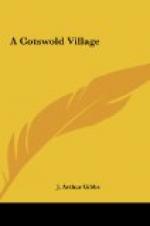There is no time of year one would sooner spend at home on Cotswold than the month of September. Nature is then at her best: the cold, bleak hills are clothed with the warmth of golden stubble; the autumnal haze now softens the landscape with those lights and shades which add so much of loveliness and sense of mystery to a hill country; the rich aftermath is full of animal life; birds of all descriptions are less wild and more easily observed than is the case later on, when the pastures and downs have been thinned by frost and there is no shelter left. Now you may see the kestrels hovering in mid air, and the great sluggish heron wending his ethereal way to the upper waters of the trout stream. You watch him till he drops suddenly from the heavens, to alight in the little valley which lies a short mile away, invisible amid the far-stretching tablelands. Occasionally, too, a marsh-harrier may be met with, but this is a rara avis even in these outlandish parts. Peregrine falcons are uncommon too, though one may yet see a pair of them now and then if one keeps a sharp look-out at all times and seasons. There are wimbrels and curlews that have been shot here during recent years stuffed and hung up in glass cases in old Mr. Peregrine’s house.
Of other birds which are becoming scarcer year by year in England, the kingfishers are not uncommon in these parts; you will often see the brilliant little fellow dart past you as you walk by the stream in summer. Water-ousels or dippers are scarce; we have seen but one specimen in the last three years.
In September, as you walk over the fields, the Cotswolds are seen at their best. Somehow or other a country never looks so well from the roads as it appears when you are in the fields. The man who prefers the high road had better not live in the Cotswolds; for these roads, mended as they are with limestone in the more remote parts of the district, become terribly sticky in winter, while the grass fields and stubbles are generally as dry as a bone. There is but a small percentage of clay in the soil, but a good deal of lime, and five inches down is the hard rock; therefore this light, stony soil never holds the rain, but allows it to percolate rapidly through, even as a sieve. When the sun is hot after a frost the ploughs “carry” certainly, but this is because they dry so quickly; they seldom remain thoroughly wet for any length of time. Consequently, in hunting, the feet of hounds, horses, and even of foxes pick up the sticky, arable soil, instead of splashing through it, and scent is spoiled thereby. Doubtless the lime in the soil adds to its stickiness. It is amusing to watch a fox “break” covert and make his way over a plough which “carries”: he travels very badly; we have seen him fail to jump a sheep hurdle at the first attempt. Fortunately for the fox, the hounds are also handicapped by these conditions, and scent is wretched. This might appear at first sight to show that the scent of foxes




